Jinxin Liu
WebSeer: Training Deeper Search Agents through Reinforcement Learning with Self-Reflection
Oct 21, 2025Abstract:Search agents have achieved significant advancements in enabling intelligent information retrieval and decision-making within interactive environments. Although reinforcement learning has been employed to train agentic models capable of more dynamic interactive retrieval, existing methods are limited by shallow tool-use depth and the accumulation of errors over multiple iterative interactions. In this paper, we present WebSeer, a more intelligent search agent trained via reinforcement learning enhanced with a self-reflection mechanism. Specifically, we construct a large dataset annotated with reflection patterns and design a two-stage training framework that unifies cold start and reinforcement learning within the self-reflection paradigm for real-world web-based environments, which enables the model to generate longer and more reflective tool-use trajectories. Our approach substantially extends tool-use chains and improves answer accuracy. Using a single 14B model, we achieve state-of-the-art results on HotpotQA and SimpleQA, with accuracies of 72.3% and 90.0%, respectively, and demonstrate strong generalization to out-of-distribution datasets. The code is available at https://github.com/99hgz/WebSeer
GLM-4.5: Agentic, Reasoning, and Coding (ARC) Foundation Models
Aug 08, 2025Abstract:We present GLM-4.5, an open-source Mixture-of-Experts (MoE) large language model with 355B total parameters and 32B activated parameters, featuring a hybrid reasoning method that supports both thinking and direct response modes. Through multi-stage training on 23T tokens and comprehensive post-training with expert model iteration and reinforcement learning, GLM-4.5 achieves strong performance across agentic, reasoning, and coding (ARC) tasks, scoring 70.1% on TAU-Bench, 91.0% on AIME 24, and 64.2% on SWE-bench Verified. With much fewer parameters than several competitors, GLM-4.5 ranks 3rd overall among all evaluated models and 2nd on agentic benchmarks. We release both GLM-4.5 (355B parameters) and a compact version, GLM-4.5-Air (106B parameters), to advance research in reasoning and agentic AI systems. Code, models, and more information are available at https://github.com/zai-org/GLM-4.5.
How does Transformer Learn Implicit Reasoning?
May 29, 2025Abstract:Recent work suggests that large language models (LLMs) can perform multi-hop reasoning implicitly -- producing correct answers without explicitly verbalizing intermediate steps -- but the underlying mechanisms remain poorly understood. In this paper, we study how such implicit reasoning emerges by training transformers from scratch in a controlled symbolic environment. Our analysis reveals a three-stage developmental trajectory: early memorization, followed by in-distribution generalization, and eventually cross-distribution generalization. We find that training with atomic triples is not necessary but accelerates learning, and that second-hop generalization relies on query-level exposure to specific compositional structures. To interpret these behaviors, we introduce two diagnostic tools: cross-query semantic patching, which identifies semantically reusable intermediate representations, and a cosine-based representational lens, which reveals that successful reasoning correlates with the cosine-base clustering in hidden space. This clustering phenomenon in turn provides a coherent explanation for the behavioral dynamics observed across training, linking representational structure to reasoning capability. These findings provide new insights into the interpretability of implicit multi-hop reasoning in LLMs, helping to clarify how complex reasoning processes unfold internally and offering pathways to enhance the transparency of such models.
ReaRAG: Knowledge-guided Reasoning Enhances Factuality of Large Reasoning Models with Iterative Retrieval Augmented Generation
Mar 27, 2025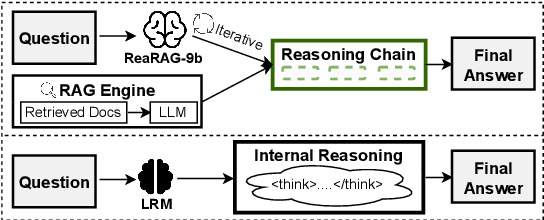
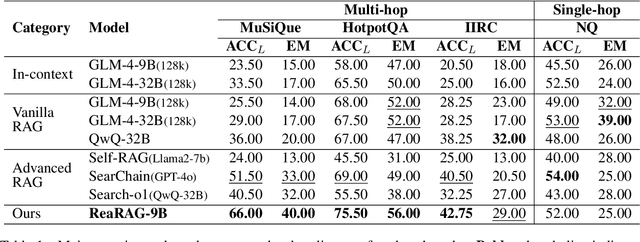
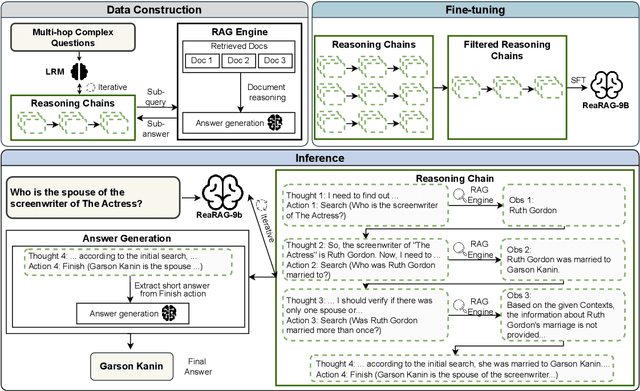

Abstract:Large Reasoning Models (LRMs) exhibit remarkable reasoning abilities but rely primarily on parametric knowledge, limiting factual accuracy. While recent works equip reinforcement learning (RL)-based LRMs with retrieval capabilities, they suffer from overthinking and lack robustness in reasoning, reducing their effectiveness in question answering (QA) tasks. To address this, we propose ReaRAG, a factuality-enhanced reasoning model that explores diverse queries without excessive iterations. Our solution includes a novel data construction framework with an upper bound on the reasoning chain length. Specifically, we first leverage an LRM to generate deliberate thinking, then select an action from a predefined action space (Search and Finish). For Search action, a query is executed against the RAG engine, where the result is returned as observation to guide reasoning steps later. This process iterates until a Finish action is chosen. Benefiting from ReaRAG's strong reasoning capabilities, our approach outperforms existing baselines on multi-hop QA. Further analysis highlights its strong reflective ability to recognize errors and refine its reasoning trajectory. Our study enhances LRMs' factuality while effectively integrating robust reasoning for Retrieval-Augmented Generation (RAG).
Humanoid-VLA: Towards Universal Humanoid Control with Visual Integration
Feb 21, 2025Abstract:This paper addresses the limitations of current humanoid robot control frameworks, which primarily rely on reactive mechanisms and lack autonomous interaction capabilities due to data scarcity. We propose Humanoid-VLA, a novel framework that integrates language understanding, egocentric scene perception, and motion control, enabling universal humanoid control. Humanoid-VLA begins with language-motion pre-alignment using non-egocentric human motion datasets paired with textual descriptions, allowing the model to learn universal motion patterns and action semantics. We then incorporate egocentric visual context through a parameter efficient video-conditioned fine-tuning, enabling context-aware motion generation. Furthermore, we introduce a self-supervised data augmentation strategy that automatically generates pseudoannotations directly derived from motion data. This process converts raw motion sequences into informative question-answer pairs, facilitating the effective use of large-scale unlabeled video data. Built upon whole-body control architectures, extensive experiments show that Humanoid-VLA achieves object interaction and environment exploration tasks with enhanced contextual awareness, demonstrating a more human-like capacity for adaptive and intelligent engagement.
LiMo-Calib: On-Site Fast LiDAR-Motor Calibration for Quadruped Robot-Based Panoramic 3D Sensing System
Feb 18, 2025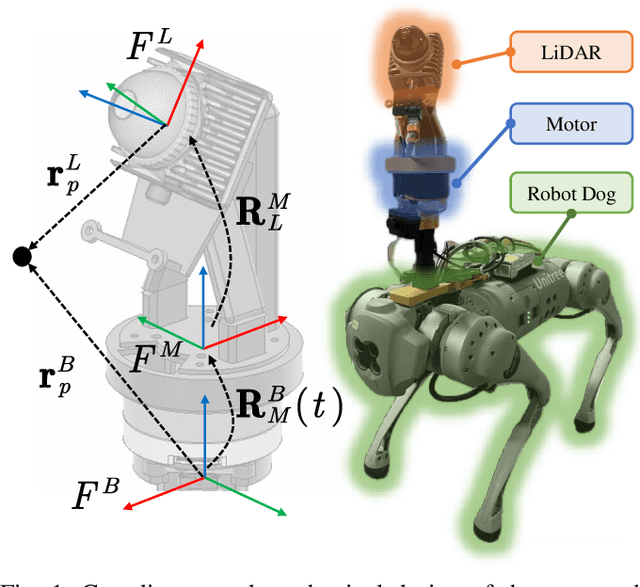
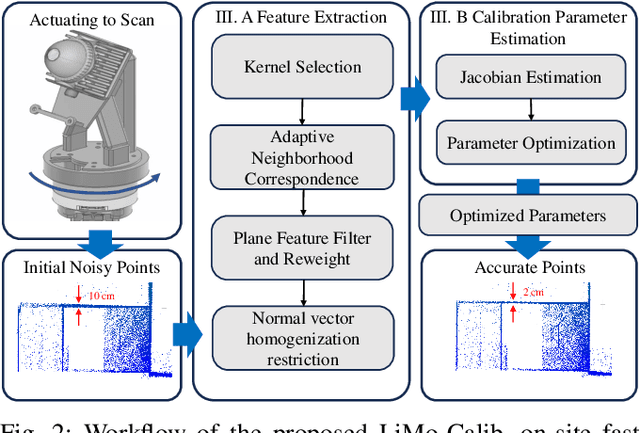
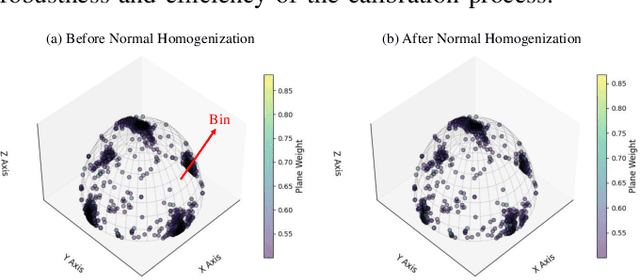

Abstract:Conventional single LiDAR systems are inherently constrained by their limited field of view (FoV), leading to blind spots and incomplete environmental awareness, particularly on robotic platforms with strict payload limitations. Integrating a motorized LiDAR offers a practical solution by significantly expanding the sensor's FoV and enabling adaptive panoramic 3D sensing. However, the high-frequency vibrations of the quadruped robot introduce calibration challenges, causing variations in the LiDAR-motor transformation that degrade sensing accuracy. Existing calibration methods that use artificial targets or dense feature extraction lack feasibility for on-site applications and real-time implementation. To overcome these limitations, we propose LiMo-Calib, an efficient on-site calibration method that eliminates the need for external targets by leveraging geometric features directly from raw LiDAR scans. LiMo-Calib optimizes feature selection based on normal distribution to accelerate convergence while maintaining accuracy and incorporates a reweighting mechanism that evaluates local plane fitting quality to enhance robustness. We integrate and validate the proposed method on a motorized LiDAR system mounted on a quadruped robot, demonstrating significant improvements in calibration efficiency and 3D sensing accuracy, making LiMo-Calib well-suited for real-world robotic applications. The demo video is available at: https://youtu.be/FMINa-sap7g
UA-MPC: Uncertainty-Aware Model Predictive Control for Motorized LiDAR Odometry
Dec 18, 2024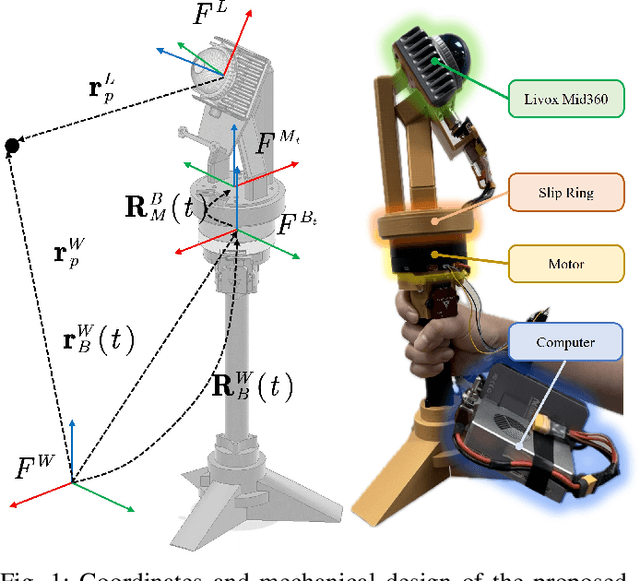


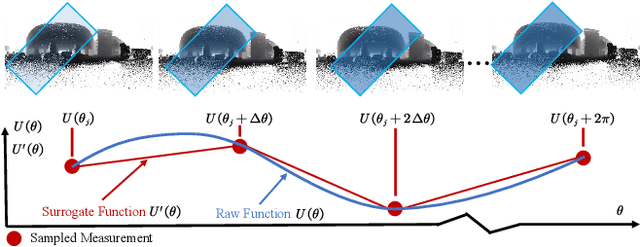
Abstract:Accurate and comprehensive 3D sensing using LiDAR systems is crucial for various applications in photogrammetry and robotics, including facility inspection, Building Information Modeling (BIM), and robot navigation. Motorized LiDAR systems can expand the Field of View (FoV) without adding multiple scanners, but existing motorized LiDAR systems often rely on constant-speed motor control, leading to suboptimal performance in complex environments. To address this, we propose UA-MPC, an uncertainty-aware motor control strategy that balances scanning accuracy and efficiency. By predicting discrete observabilities of LiDAR Odometry (LO) through ray tracing and modeling their distribution with a surrogate function, UA-MPC efficiently optimizes motor speed control according to different scenes. Additionally, we develop a ROS-based realistic simulation environment for motorized LiDAR systems, enabling the evaluation of control strategies across diverse scenarios. Extensive experiments, conducted on both simulated and real-world scenarios, demonstrate that our method significantly improves odometry accuracy while preserving the scanning efficiency of motorized LiDAR systems. Specifically, it achieves over a 60\% reduction in positioning error with less than a 2\% decrease in efficiency compared to constant-speed control, offering a smarter and more effective solution for active 3D sensing tasks. The simulation environment for control motorized LiDAR is open-sourced at: \url{https://github.com/kafeiyin00/UA-MPC.git}.
AtomR: Atomic Operator-Empowered Large Language Models for Heterogeneous Knowledge Reasoning
Nov 25, 2024



Abstract:Recent advancements in large language models (LLMs) have led to significant improvements in various natural language processing tasks, but it is still challenging for LLMs to perform knowledge-intensive complex question answering due to LLMs' inefficacy in reasoning planning and the hallucination problem. A typical solution is to employ retrieval-augmented generation (RAG) coupled with chain-of-thought (CoT) reasoning, which decomposes complex questions into chain-like sub-questions and applies iterative RAG at each sub-question. However, prior works exhibit sub-optimal reasoning planning and overlook dynamic knowledge retrieval from heterogeneous sources. In this paper, we propose AtomR, a novel heterogeneous knowledge reasoning framework that conducts multi-source reasoning at the atomic level. Drawing inspiration from the graph modeling of knowledge, AtomR leverages large language models (LLMs) to decompose complex questions into combinations of three atomic knowledge operators, significantly enhancing the reasoning process at both the planning and execution stages. We also introduce BlendQA, a novel evaluation benchmark tailored to assess complex heterogeneous knowledge reasoning. Experiments show that AtomR significantly outperforms state-of-the-art baselines across three single-source and two multi-source reasoning benchmarks, with notable performance gains of 9.4% on 2WikiMultihop and 9.5% on BlendQA.
Deep Learning-Assisted Jamming Mitigation with Movable Antenna Array
Oct 27, 2024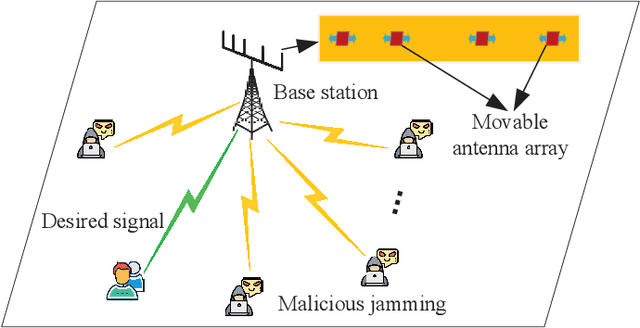

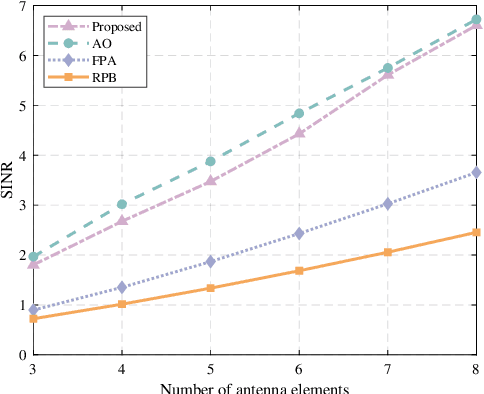
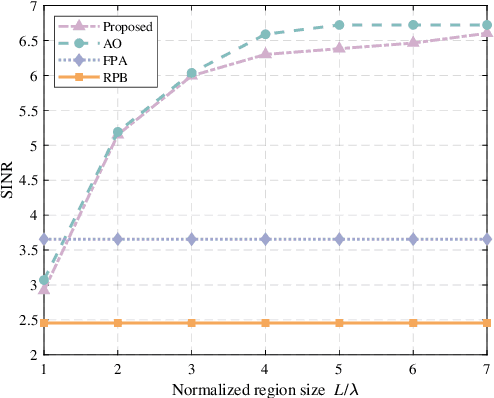
Abstract:This paper reveals the potential of movable antennas in enhancing anti-jamming communication. We consider a legitimate communication link in the presence of multiple jammers and propose deploying a movable antenna array at the receiver to combat jamming attacks. We formulate the problem as a signal-to-interference-plus-noise ratio maximization, by jointly optimizing the receive beamforming and antenna element positioning. Due to the non-convexity and multi-fold difficulties from an optimization perspective, we develop a deep learning-based framework where beamforming is tackled as a Rayleigh quotient problem, while antenna positioning is addressed through multi-layer perceptron training. The neural network parameters are optimized using stochastic gradient descent to achieve effective jamming mitigation strategy, featuring offline training with marginal complexity for online inference. Numerical results demonstrate that the proposed approach achieves near-optimal anti-jamming performance thereby significantly improving the efficiency in strategy determination.
Towards Evaluating and Building Versatile Large Language Models for Medicine
Aug 22, 2024Abstract:In this study, we present MedS-Bench, a comprehensive benchmark designed to evaluate the performance of large language models (LLMs) in clinical contexts. Unlike existing benchmarks that focus on multiple-choice question answering, MedS-Bench spans 11 high-level clinical tasks, including clinical report summarization, treatment recommendations, diagnosis, named entity recognition, and medical concept explanation, among others. We evaluated six leading LLMs, e.g., MEDITRON, Mistral, InternLM 2, Llama 3, GPT-4, and Claude-3.5 using few-shot prompting, and found that even the most sophisticated models struggle with these complex tasks. To address these limitations, we developed MedS-Ins, a large-scale instruction tuning dataset for medicine. MedS-Ins comprises 58 medically oriented language corpora, totaling 13.5 million samples across 122 tasks. To demonstrate the dataset's utility, we conducted a proof-of-concept experiment by performing instruction tuning on a lightweight, open-source medical language model. The resulting model, MMedIns-Llama 3, significantly outperformed existing models across nearly all clinical tasks. To promote further advancements in the application of LLMs to clinical challenges, we have made the MedS-Ins dataset fully accessible and invite the research community to contribute to its expansion.Additionally, we have launched a dynamic leaderboard for MedS-Bench, which we plan to regularly update the test set to track progress and enhance the adaptation of general LLMs to the medical domain. Leaderboard: https://henrychur.github.io/MedS-Bench/. Github: https://github.com/MAGIC-AI4Med/MedS-Ins.
 Add to Chrome
Add to Chrome Add to Firefox
Add to Firefox Add to Edge
Add to Edge